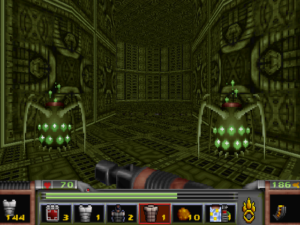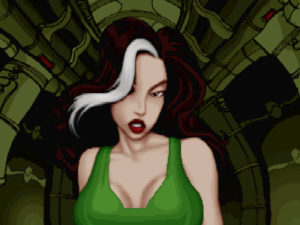Strife: Final thoughts
 Obtaining the last piece of the Five-Fingered Fist of God (as I like to think of it) opens up a passage to the alien spacecraft that started the whole mess. Not that I’d have guessed that is was an alien spacecraft without the level’s name in the automap screen. The decor is less technological-looking than a lot of the areas that are supposed to be castles and chapels and the like, consisting mainly of busy green textures that look like jade inlays or something. (I can accept that alien technology looks different from ours, but this alien is supposed to be the source of all the advanced technology we’ve seen in the game.)
Obtaining the last piece of the Five-Fingered Fist of God (as I like to think of it) opens up a passage to the alien spacecraft that started the whole mess. Not that I’d have guessed that is was an alien spacecraft without the level’s name in the automap screen. The decor is less technological-looking than a lot of the areas that are supposed to be castles and chapels and the like, consisting mainly of busy green textures that look like jade inlays or something. (I can accept that alien technology looks different from ours, but this alien is supposed to be the source of all the advanced technology we’ve seen in the game.)
This section made me very apprehensive. Not because of the darkness, or the whispery voices that get louder as you progress, but because of its generosity. The very first room in the alien ship is a smorgasbord of ammo and healing items, the sort of thing that says “You’re going to need this.” In a game where rooms like this occur frequently, like Serious Sam, this wouldn’t mean much. But here, the game had been very stingy with me for a long time, so the sudden change of heart seemed to signal something very bad to come.
This was followed by a cavernous room packed with monsters, including an Inquisitor and multiple Crusaders. At any prior point in the game, this would have been very difficult, as I’d be dodging missiles from multiple directions. As it was, I more or less stood at the entrance and let the Five-Fingered Fist of God clear out most of the room. It wasn’t quite as thorough as Doom‘s BFG would have been, so I did in fact have to use a little of my freshly-snagged ammo for mopping up, but I still hoarded most of it. After that came a couple more supply caches, including one so full of Energy Cells and Full Healths that I had to leave most of them behind.
(Energy cells are the ammo for the Mauler, the second most powerful weapon in the game. It’s kind of like the standard FPS shotgun (otherwise absent here) in that it has a slow rate of fire and does damage in a scatter pattern, but it’s a scatter of disintegration beams that are still pretty effective at a long distance. Looking it up just now to find its name, I discovered that it has an alternate fire mode that I didn’t know about and never used, a “torpedo mode” that fires an energy ball that breaks into more energy balls on impact. Maybe that would have helped in that stretch where I had so much trouble. It sounds like a real room-clearer.)
After the Energy Cell cache was a new level called “Entity’s Lair”, which the automap claimed had no monsters at all. Furthermore, just walking around opened another cache containing more Energy Cells. My apprehension increased. What on earth was going on?
Well, it turned out that this was in fact the level with the final boss. (When it made its appearance, the map mode updated the monster count to 1.) And it was kind of anticlimactic — definitely not the hardest fight in the game, not with the Fist of God at my side. Maybe the point behind all that Mauler ammo was to trick you into using it instead. I didn’t even try. After spending so much time hunting for pieces of the Sigil, it seemed like a waste to not use it.
 The game doesn’t waste much time on what happens after you’re done fighting. There are multiple possible endings, but in the one I got, there’s a perfunctory illustrated slideshow cutscene in which it’s asserted that everything is hunky-dory now, and then Blackbird emerges from the woodwork with a come-hither glance, intending to (in her words) “reward you… personally” for some reason. And that’s that! Look at any writeup of Doom-style games, and you’ll find Strife praised for its rich, deep plot. And, well, it has a plot. The mere fact that it’s there is enough to make it seem deep and rich in comparison to other Doom-likes.
The game doesn’t waste much time on what happens after you’re done fighting. There are multiple possible endings, but in the one I got, there’s a perfunctory illustrated slideshow cutscene in which it’s asserted that everything is hunky-dory now, and then Blackbird emerges from the woodwork with a come-hither glance, intending to (in her words) “reward you… personally” for some reason. And that’s that! Look at any writeup of Doom-style games, and you’ll find Strife praised for its rich, deep plot. And, well, it has a plot. The mere fact that it’s there is enough to make it seem deep and rich in comparison to other Doom-likes.
So, looking back on the experience, I have to ask: apart from some amusement and sating my sense of completism, did I get anything out of this game? Does it have anything to teach us? Obviously it did when it was new: it introduced Doom fans to the concept of NPCs, and experimented with combining FPS and RPG elements. And as fond as I am of saying “Ultima Underworld did it first”, I have to admit that Strife chose a fresh approach to that combination, one that emphasizes the FPS part and makes the RPG aspect subordinate to it. 1I say “chose”, but this may or may not have been the authors’ intention. The emphasis may have been a result of the engine.
There’s also at least one original, and still-underutilized, pure-FPS idea in here too: use of the ceiling. People don’t normally look at ceilings, so things up there can be hard to spot. (Especially in places where the ceilings are high, because the graphics engine used here only lets you raise the view so far.) So Strife gives you ceiling-mounted automated gun turrets — stationary turrets themselves being something of a new wrinkle at the time — and it gives you Stalkers, small spider-bots that crawl on the ceilings and drop down behind you to attack. Stalkers make a distinctive ticking noise as they creep along, and whenever I heard it, I knew I was probably also going to hear the plunk that meant I should sprint forward a few yards and then quickly turn around.
On the side of negative lessons, the one place where I felt that Strife really fell down was that it wasn’t clear enough in the beginning about how things work. Which is a very unusual problem for a FPS, but there it is. The person who gives you your first mission warns you not to “set off every alarm in town”, so when you set off an unavoidable alarm in the course of that mission, it’s easy to feel like you’ve made a mistake and waste some time looking for a way around it. At the same time, there’s another person not far away who offers you a similar mission, but he’s a liar and fraud, and secretly in league with the Order: doing as he says does in fact set off every alarm in town, which can disastrous if you chose to do his mission first. Something like that might have been okay later in the game — arguably the business with Macil is similar — but when you’re still struggling with the basics, like where you are and who the Front is and whether you should be accepting missions from strangers at all, it just adds to the confusion.
For that matter, the game itself never addresses the questions of your immediate situation. The moment you select “New Game”, you’re in a room in a sewage treatment plant, armed with only a knife and being attacked by an Acolyte, with no clue of why. The in-game intro tells you about the history of the Order, but nothing about your personal history — even the detail that you’re a “wandering mercenary” is only mentioned in the manual. This strikes me as exactly backward. The important thing for the intro to do is establish your place in this world, to orient you. The details of the environment can be revealed over the course of the game, or relegated to the docs. I think of Half-Life 2 and Quake 2, where the opening cutscene is all about showing how the player character arrives in the gameworld.
Anyway, I’m glad I played it, but I don’t think I’ll be trying for the other endings. (The cutscenes can all be found on Youtube anyway.) For next time, I’m going to try to wrap up some other stuff that I’ve started but not finished on this blog.
| ↑1 | I say “chose”, but this may or may not have been the authors’ intention. The emphasis may have been a result of the engine. |
|---|
 Comments(3)
Comments(3)
It’s kind of funny that a game with a setting as relatively FPS-stock as Strife’s is much more of an RPG than Heretic or Hexen, which draw very directly on the sort of setting that you’d find in your average RPG.
greatest review of strife ever. i’m so glad this game is being revisited now.
Agree! great strife review, I enjoyed reading it.